Sensitivity of cochlear nucleus neurons to spatio-temporal changes in auditory nerve activity
- PMID: 22972956
- PMCID: PMC3544887
- DOI: 10.1152/jn.00160.2012
Sensitivity of cochlear nucleus neurons to spatio-temporal changes in auditory nerve activity
Abstract
The spatio-temporal pattern of auditory nerve (AN) activity, representing the relative timing of spikes across the tonotopic axis, contains cues to perceptual features of sounds such as pitch, loudness, timbre, and spatial location. These spatio-temporal cues may be extracted by neurons in the cochlear nucleus (CN) that are sensitive to relative timing of inputs from AN fibers innervating different cochlear regions. One possible mechanism for this extraction is "cross-frequency" coincidence detection (CD), in which a central neuron converts the degree of coincidence across the tonotopic axis into a rate code by preferentially firing when its AN inputs discharge in synchrony. We used Huffman stimuli (Carney LH. J Neurophysiol 64: 437-456, 1990), which have a flat power spectrum but differ in their phase spectra, to systematically manipulate relative timing of spikes across tonotopically neighboring AN fibers without changing overall firing rates. We compared responses of CN units to Huffman stimuli with responses of model CD cells operating on spatio-temporal patterns of AN activity derived from measured responses of AN fibers with the principle of cochlear scaling invariance. We used the maximum likelihood method to determine the CD model cell parameters most likely to produce the measured CN unit responses, and thereby could distinguish units behaving like cross-frequency CD cells from those consistent with same-frequency CD (in which all inputs would originate from the same tonotopic location). We find that certain CN unit types, especially those associated with globular bushy cells, have responses consistent with cross-frequency CD cells. A possible functional role of a cross-frequency CD mechanism in these CN units is to increase the dynamic range of binaural neurons that process cues for sound localization.
Figures


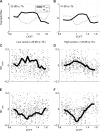

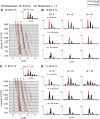

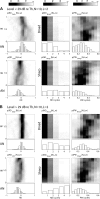
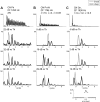


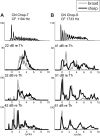


Similar articles
-
Linear coding of complex sound spectra by discharge rate in neurons of the medial nucleus of the trapezoid body (MNTB) and its inputs.Front Neural Circuits. 2014 Dec 16;8:144. doi: 10.3389/fncir.2014.00144. eCollection 2014. Front Neural Circuits. 2014. PMID: 25565971 Free PMC article.
-
Lateral suppression and inhibition in the cochlear nucleus of the cat.J Neurophysiol. 1994 Feb;71(2):493-514. doi: 10.1152/jn.1994.71.2.493. J Neurophysiol. 1994. PMID: 8176421
-
Encoding timing and intensity in the ventral cochlear nucleus of the cat.J Neurophysiol. 1986 Aug;56(2):261-86. doi: 10.1152/jn.1986.56.2.261. J Neurophysiol. 1986. PMID: 3760921
-
The volley theory and the spherical cell puzzle.Neuroscience. 2008 Jun 12;154(1):65-76. doi: 10.1016/j.neuroscience.2008.03.002. Epub 2008 Mar 8. Neuroscience. 2008. PMID: 18424004 Free PMC article. Review.
-
Regulation of the timing of MNTB neurons by short-term and long-term modulation of potassium channels.Hear Res. 2005 Aug;206(1-2):133-45. doi: 10.1016/j.heares.2004.11.023. Hear Res. 2005. PMID: 16081004 Review.
Cited by
-
Modeling binaural responses in the auditory brainstem to electric stimulation of the auditory nerve.J Assoc Res Otolaryngol. 2015 Feb;16(1):135-58. doi: 10.1007/s10162-014-0492-6. Epub 2014 Oct 28. J Assoc Res Otolaryngol. 2015. PMID: 25348578 Free PMC article.
-
Hypotheses relating to the function of the claustrum II: does the claustrum use frequency codes?Front Integr Neurosci. 2014 Jan 29;8:7. doi: 10.3389/fnint.2014.00007. eCollection 2014. Front Integr Neurosci. 2014. PMID: 24523681 Free PMC article. No abstract available.
-
Effects of sensorineural hearing loss on temporal coding of narrowband and broadband signals in the auditory periphery.Hear Res. 2013 Sep;303:39-47. doi: 10.1016/j.heares.2013.01.014. Epub 2013 Jan 29. Hear Res. 2013. PMID: 23376018 Free PMC article. Review.
-
Hierarchical differences in the encoding of sound and choice in the subcortical auditory system.J Neurophysiol. 2023 Mar 1;129(3):591-608. doi: 10.1152/jn.00439.2022. Epub 2023 Jan 18. J Neurophysiol. 2023. PMID: 36651913 Free PMC article.
-
Improved Neural Coding of ITD with Bilateral Cochlear Implants by Introducing Short Inter-pulse Intervals.J Assoc Res Otolaryngol. 2018 Dec;19(6):681-702. doi: 10.1007/s10162-018-00693-0. Epub 2018 Sep 6. J Assoc Res Otolaryngol. 2018. PMID: 30191423 Free PMC article.
References
-
- Babalian AL, Jacomme AV, Doucet JR, Ryugo DK, Rouiller EM. Commissural glycinergic inhibition of bushy and stellate cells in the anteroventral cochlear nucleus. Neuroreport 13: 555–558, 2002 - PubMed
-
- Blackburn CC, Sachs MB. Classification of unit types in the anteroventral cochlear nucleus: post-stimulus time histograms and regularity analysis. J Neurophysiol 62: 1303–1329, 1989 - PubMed
-
- Bourk TR. Electrical Responses of Neural Units in the Anteroventral Cochlear Nucleus of the Cat (PhD thesis). Cambridge, MA: MIT, 1976
-
- Brand A, Behrend O, Marquardt T, McAlpine D, Grothe B. Precise inhibition is essential for microsecond interaural time difference coding. Nature 417: 543–547, 2002 - PubMed
-
- Bruce IC, Sachs MB, Young ED. An auditory-periphery model of the effects of acoustic trauma on auditory nerve responses. J Acoust Soc Am 113: 369–388, 2003 - PubMed
MeSH terms
Grants and funding
LinkOut - more resources
Full Text Sources

